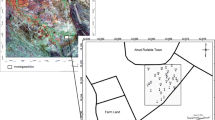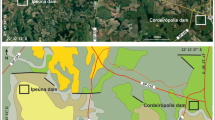Abstract
Electrical resistivity survey and the geotechnical SPT blow counts (N value) method were simultaneously analyzed to investigate the stability of a center-core type earth-fill dam against the seepage phenomenon. The coupling of these heterogeneous field methods provided a chance to understand the status of underground material by comparing the geophysical and geotechnical view. The analysis shows that the zones with low resistivity value generally have low N value, which means low stiffness. However, some zones with a high resistivity pattern are not accompanied by an increase of its N value, and are even showing a lower N value. These results imply that one should be careful to directly correlate resistivity value with the real status of the core material of a fill dam. And a highly resistive zone may be in poor status due to the effect of increase of resistivity value as a result of the piping condition. Additional laboratory tests show that there is a deficiency of fine soil particles believed as the clay at the troubled region, which means an increase in resistivity value. Therefore, multiple explorations should be planned to reduce the uncertainty in application of geophysical methods to dam safety evaluation in order to compensate the resistivity information of core material.








Similar content being viewed by others
References
Aggour MS, Radding WR (2001) Standard penetration test (SPT) correction. Report No. MD02-007B48, Maryland State Highway Administration, Baltimore, 87 p
ASTM (2002) Standard test method for penetration test and split-barrel sampling of soils (D 1586–1999). Annual book of ASTM standards. Sect. 4, vol. 04.08, American Society for Testing and Materials, Philadelphia, pp 146–150
Bergstrom J (1998) Geophysical methods for investigating and monitoring the integrity of sealing layer on mining waste deposits. Licentiate Thesis, Lulea University of Technology, Lulea, Sweden
Bowles JE (1996) Foundation analysis and design, 5th edn. McGraw-Hill, Singapore, pp 135–166
Johansson S, Dahlin T (2000) Seepage monitoring by resistivity and streaming potential measurements at Hallby embankment dam 1996–1999. Report 00:15, Elforsk, Stockholm
Kulhawy FH, Mayne PW (1990) Manual on estimating soil properties for foundation design. Final report no. EL-6800, Electric Power Research Institute, Palo Alto, 306 p
Liao SSC, Whitman RV (1986) Overburden correction factors for SPT in sand. J Geotech Eng ASCE 112:1449–1459
Panthulu TV, Krishnaiah C, Shirke JM (2001) Detection of seepage paths in earth dams using self-potential and electrical resistivity methods. Eng Geol 59:281–295
Sjodahl P, Dahlin T, Zhou B, Johansson S (2002) Monitoring of leakage in embankment dams through resistivity measurements—2.5D modeling study. In: 8th meeting of environmental and engineering geophysics, Portugal
Skempton AW (1986) Standard penetration test procedures and the effects in sands of overburden pressure, relative density, particle size, aging and overconsolidation. Geotechnique 36:425–447
Song SH, Song Y, Kwon BD (2005) Application of hydrogeological and geophysical methods to delineate leakage pathways in an earth fill dam. Special issue published jointly by ASEG 36, SEGJ 58, KSEG, vol 8, pp 92–96
Titov K, Ilyin U, Konosavski P, Levitski A (2002) Electrokinetic spontaneous polarization in porous media: petrophysics and numerical modeling. J Hydrol 267:207–216
Yi MJ, Kim JH, Chung SH (2003) Enhancing the resolving power of least-squares inversion with active constraint balancing. Geophysics 68:931–941
Acknowledgments
Suggestions and comments from Dr. Enzo Rizzo, an anonymous reviewer, and associate editor Dr. Mark Bultman helped us to improve the manuscript significantly. This work was supported by the Korea Research Foundation Grant funded by the Korean Government (MOEHRD, Basic Research Promotion Fund) (KRF-2006-003-D00709) and the research project (NP2007-015) of the Korea Institute of Geoscience and Mineral Resources (KIGAM) funded by the Ministry of Commerce, Industry and Energy of Korea.
Author information
Authors and Affiliations
Corresponding author
Rights and permissions
About this article
Cite this article
Oh, S., Sun, CG. Combined analysis of electrical resistivity and geotechnical SPT blow counts for the safety assessment of fill dam. Environ Geol 54, 31–42 (2008). https://doi.org/10.1007/s00254-007-0790-y
Received:
Accepted:
Published:
Issue Date:
DOI: https://doi.org/10.1007/s00254-007-0790-y




